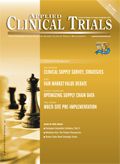Breathe Easier: Cancer R&D Innovation Puts Strong Focus on the Lung
IMS Health
Innovation in oncology continues to dominate the drug development pipeline, with accelerated approvals, increased funding and awareness, and an overall pipeline of almost 2,000 active products under study accounting for one-third of all pharmaceutical R&D. However, while many oncology indications are experiencing success in life extension with overall five-year survival rates at more than 66%, others such as lung cancer are struggling to achieve the same results, with a mere 16.8% of patients achieving five-year survival. While these rates may be low, innovation in lung cancer is at an all-time high; extending survival of lung cancer patients has become a large industry investment.

However, an interesting finding is that the U.S. has remained cost neutral over the last five years in R&D cost per-patient spend, in addition to remaining visit neutral in the area of lung cancer research (see chart). Ex-U.S. has experienced the opposite—with a correlation between increased patient visits and increased per-patient spend. What is fueling this increase in activity? Is this purely a result of globalization of research over the past five years? Or perhaps the U.S. has become more efficient in execution, thus controlling spend, but with little new outcomes. — IMS Health

Unifying Industry to Better Understand GCP Guidance
May 7th 2025In this episode of the Applied Clinical Trials Podcast, David Nickerson, head of clinical quality management at EMD Serono; and Arlene Lee, director of product management, data quality & risk management solutions at Medidata, discuss the newest ICH E6(R3) GCP guidelines as well as how TransCelerate and ACRO have partnered to help stakeholders better acclimate to these guidelines.
Gilead Shares Final Data from Phase III MYR301 Trial of Bulevirtide in Chronic Hepatitis Delta Virus
May 7th 2025Long-term results from the study show 90% of patients with chronic HDV who achieved undetectable HDV RNA at 96 weeks of treatment remained undetectable for nearly 2 years post-treatment.